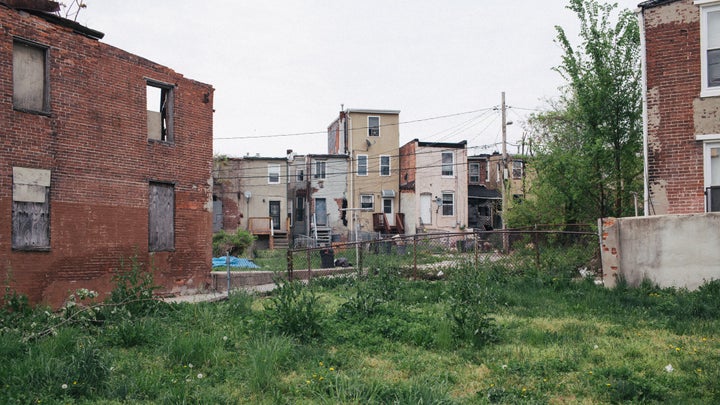
BALTIMORE -- “Stunning” was the only word Sen. Bernie Sanders (I-Vt.) could find to describe one of Charm City’s most poverty-stricken areas.
It was a cold Tuesday morning when the 2016 Democratic presidential candidate, along with a montage of reporters, clergymen and residents, moved solemnly down the streets of Sandtown-Winchester, the neighborhood that was home to Freddie Gray, a 25-year-old black man who died after a "rough ride" in police custody in April.
Like other low-income neighborhoods in the city, abandoned homes line the streets of Sandtown. Rowhouses full of activity give way to entire blocks of empty, boarded-up homes.
There are about 46,800 vacant homes in Baltimore, according to the U.S. Census Bureau. City officials count 16,745, but that count only includes properties considered uninhabitable, excluding thousands of homes that are livable but empty.
Some of the blight can be attributed to a drop in population. During the post-World War II boom of the 1950s, around 900,000 people lived in Baltimore. Now, the city, which was designed to lodge nearly 1 million people, is home to around 622,000.
Based on the city’s official count, more than 800 -- about 5 percent -- of Baltimore’s vacant properties are in Sandtown-Winchester, which accounts for less than 1 percent of the city's total land area.
“We are the wealthiest country in the history of the world, and every year we're seeing more and more millionaires and more and more billionaires," Sanders said Tuesday in Sandtown. "But in communities like this, what we're seeing is kids dropping out of schools, being in bad schools, being in dilapidated housing.”
The Democratic presidential candidate couldn't have picked a better place to talk about housing issues. Freddie Gray's neighborhood -- and Baltimore neighborhoods in general -- are emblematic of America's housing crisis. Here's why.
Staggering Eviction Rates

It's not uncommon to walk down the streets in some parts of of Baltimore and see piles of belongings left on the curb. Since 2012, more than 6,800 renters and their families have been evicted annually in the city, according to a report from the Public Justice Center released this month. The city has the second-highest percentage of renters facing eviction due to an inability to pay rent in the nation. Only Detroit has more renters in danger of losing their homes.
“Many of these struggling renters feel that the public has tuned out their stories or flipped those stories against them.” the report says. “They face complex legal challenges on their own, without an attorney or even legal information to know their rights. At the same time, city leaders show little interest in understanding the cause of these evictions and their effects on community, family, employment, health and education.”
These issues are a reflection of Baltimore's housing market. Over half of the city’s households are renting, and most of them fall into the “very low income” category. The median income for renters sits at $27,000, the report found. Three in every five households in the city earn under $35,000. Citywide, around 25 percent of renting households spend at least 50 percent of their annual income on rent.
The high-eviction rate falls on the shoulders of the Baltimore City Rent Court. According to the report, the courts favor landlords over “long-standing tenant protections and basic housing standards.”
“Without intervention, it will only continue to function as a housed-to-homeless pipeline, a core disruptor of Baltimore’s efforts to foster community, family health, childhood education, and neighborhood stabilization,” the report says.
Horrid Living Conditions
Leaky roofs, inoperable appliances, rodent infestations, collapsed floors and ceilings are a few of the the deplorable conditions judges in Baltimore’s rent court system have a tendency to ignore, the report says.
Almost 60 percent of people who were summoned to rent court in Baltimore said their homes were infested with insects or rodents. Of the 300 people surveyed by the Right to Housing Alliance, Public Justice Center's partner on the report, 72 percent of them said they had notified their landlord of the problem before their trial date.
“These results demonstrate that most Rent Court defendants -- 57 percent of all survey respondents -- have good cause not to pay at least some portion of their rents,” the report says.
In the city’s public housing units, these problems exist in rare form. An investigation by The Baltimore Sun found that the city’s Housing Authority -- which services 11,000 homes -- has a backlog of over 4,000 work orders where tenants have waited over 30 days for repairs to be completed. Some, the investigation discovered, have waited over a year.
Over 1,000 requests pertained to plumbing issues; 1,700 requests had been filed for broken windows, doors and locks; 387 called attention to broken appliances; and over 200 households had waited over a month for exterminators.
In some cases, public housing residents have alleged that maintenance workers from the Housing Authority asked for sexual favors in exchange for repairs.
A Legacy Of Lead Paint
Baltimore became the first city to ban the use of lead pigments in interior paint in 1951, but since many of the city’s homes were built during a period when lead paint was widely used, many residents are still exposed.
“Across the United States, more than half a million kids are poisoned by lead each year, and the majority come from cities like Baltimore: rust belt towns built up during the first half of the 20th century when leaded paint was dominant,”Anna Maria Barry-Jester wrote for FiveThirtyEight in May. “As populations and employment opportunities shrank in recent decades, poverty and neglect combined with older housing allowed lead paint poisoning to plague the city.”
Between 1993 and 2013, Maryland state tests discovered that over 65,000 children in Baltimore had dangerously high levels of lead in their blood. Granted, the number of new cases of lead poisoning has dropped by 86 percent since 2002 in Baltimore, but the city still sits at nearly three times the national rate of childhood lead poisoning. It’s possible, according to The Baltimore Sun, that the number of children exposed is even higher, since not all children are tested.
Six neighborhoods -- including Sandtown -- are responsible for the majority of the lead-poisoning cases seen in the last five years. The epidemic hasn’t ceased, due to a lack of enforcement and inaccurate data, a Baltimore Sun investigation discovered.
Further progress is hindered, advocates say, because the state lead paint law is largely self-enforced. The state requires landlords to have their properties inspected for lead paint hazards, but rarely checks. A state or city worker typically visits a rental unit only after a routine medical test finds a child has been poisoned, or if someone complains. And even then, cases fall through the cracks.
Studies have shown that lead poisoning can cause a decrease in IQ, behavioral disorders, hyperactivity and a lack of impulse control -- all of which can lead to high crime rates and a high number of repeat offenders. In August, the U.S. housing secretary announced that Baltimore City would receive a $4 million grant to fight the risk of lead poisoning.

“What you gon' do with all this, Bernie?” shouted one man running alongside Bernie’s entourage as it advanced down the streets of Sandtown-Winchester.
Many Sandtown residents who spoke to The Huffington Post were skeptical of Sanders and what he could do to improve the conditions they face. In addition to housing, over half of all people released from Maryland's prison system annually return to Sandtown-Winchester. The violent crime rate in the neighborhood is six times the national rate; 50 percent of residents ages 16 to 64 are unemployed; and many people end up with minor drug convictions, limiting already-scarce job opportunities.
“What he gon’ do? What can he do for us? I mean, there ain’t too much they can do,” said Tony Morallis, a resident of Sandtown-Winchester. “They ain’t done nothing yet. No changes been going on. The same thing still been going on.”
Correction: A previous version of this article said the Public Justice Center surveyed 300 people for the report; in fact, it was the Right to Housing Alliance.
